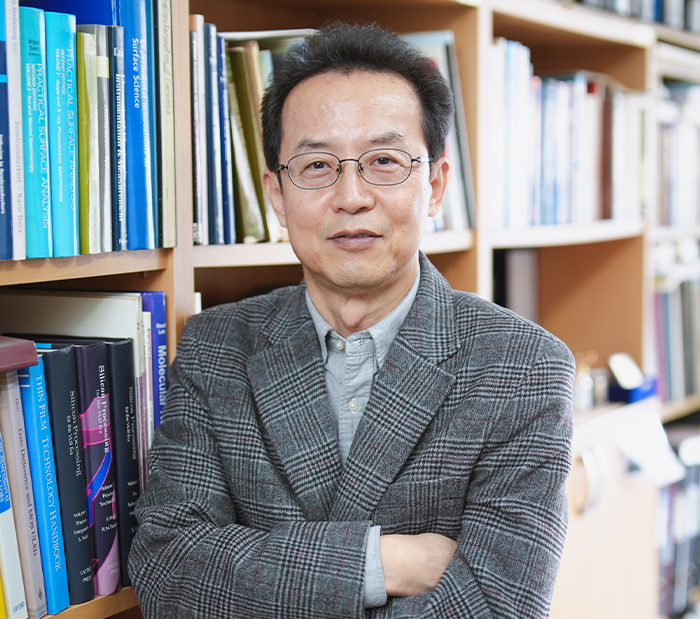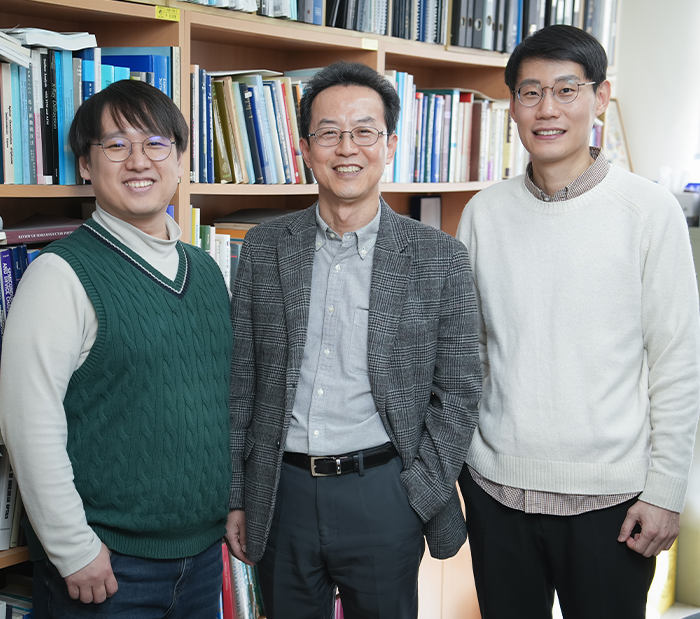Predicting and demonstrating of hidden metastable phase in transition metal oxide
Advanced Materials Science and Engineering LEE, JAICHAN Prof. · Bongwook Chung
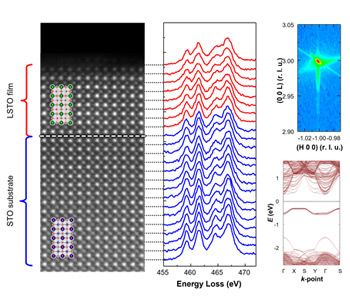
-
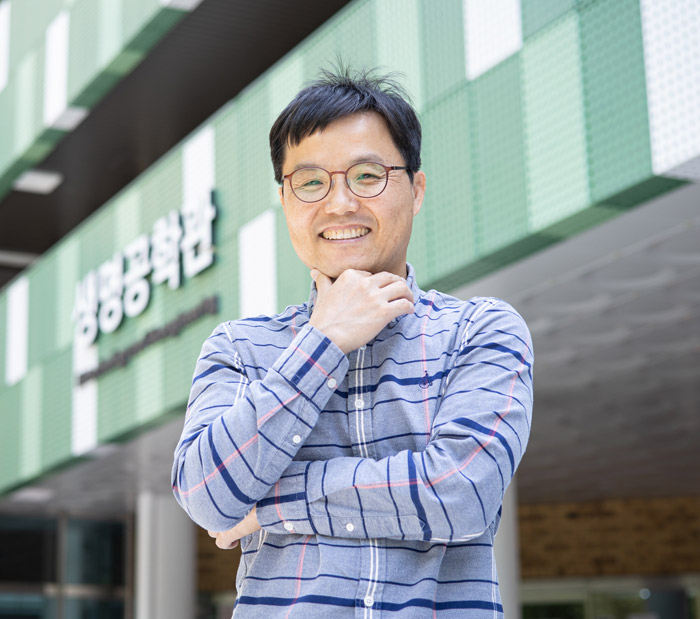
Bio-Mechatronic Engineering KIM, GEUNHYUNG Prof. ·Hwangbo Hanjun, Dr. Hyeongin Lee
Bone Tissue Engineering via Application of a Collagen/Hydroxyapatite 4D-printed Biomimetic Scaffold for Spinal Fusion
In an aging population, the frequency of patients with spine-related problems such as spinal stenosis, vertebral fractures, progressive deformities, and instability has shown a concerning increase. Due to the superior biological properties, biomimetic bone grafts have been long considered to be the reference standard for successful bone tissue regeneration and spinal fusion. Prof. Geun Hyung Kim and his research team (Hanjun Hwangbo and Dr. Hyeongjin Lee; first author) from the department of biomechatronic engineering / biomedical institute for Convergence at SKKU (BICS) conducted joint research with Prof. In-Bo Han and his research team (Eun Ji Roh; first author) from CHA University School of medicine to develop 4D printing strategy to fabricate biomimetic microchanneled collagen/hydroxyapatite scaffold (MC- scaffold). The fabricated MC- scaffold was further analyzed in a spinal fusion model of a mouse. Consequently, the results indicate significantly higher bone regeneration and rate of spine fusion compared to the conventionally fabricated collagen/hydroxyapatite scaffold. A major drawback of the conventionally used bone grafts is the limited vascular network causing insufficient nutrient and metabolite transfer to the surrounding tissue. To overcome this issue, Prof Geun Hyung Kim and his research team utilized a 4D printing strategy (one-way-shape-morphing) to fabricate a biomimetic microchanneled scaffold composed of collagen and hydroxyapatite (the main component of native bone) to induce a higher degree of osteogenesis and angiogenesis. These findings are owed to the synergistic effects of high infiltration of blood vessels into the microchannels and superior biophysical properties of the microchanneled collagen/hydroxyapatite scaffold. Additionally, Prof. Geun Hyung Kim and his research team (WonJin Kim; first author) collaborated with Prof. SangJin Lee and his research team (Dr. Hyeongjin Lee; first author) from Wake Forest Institute for Regenerative Medicine (WFIRM) applied 4D printing strategy to induce cellular alignment in extracellular matrix (ECM) based scaffold. Subsequently, a significantly higher degree of muscle regeneration was observed via implantation of the 4D printed bioconstruct into a muscle defect in the rat model. Currently, mimicking the uniaxial alignment of muscle cells as presented in the native skeletal muscle is often a challenging and difficult task to accomplish with conventional 3D printing. To overcome this issue, Prof. Geun Hyung Kim and his research team utilized developed a composite bioink composed of natural polymer (ECM) and synthetic polymer (Polyvinyl alcohol, PVA), and a 4D printing strategy to provide topographical cue in ECM-based scaffold to induce cellular alignment of primary human muscle progenitor cell (hMPC). Various process parameters such as PVA molecular weight and pneumatic pressure have been analyzed to optimized to obtain the best biological factors such as cellular alignment and differentiation of the host cells. In addition, to conduct in vivo investigations into muscle regeneration, the bioconstruct sized 15 × 7 × 3 mm3 have been printed and implanted into the tibialis anterior (TA) muscle defect. The cell viability of the fabricated bioconstruct was measured to be around 90%. After 8 weeks of implantation, the muscle regeneration on rats that received the 4D bioprinted structure was significantly higher compared to the conventional 3D printed structure. The presented 4D printing strategy enables versatility of designing various biological and physical factors of the implant grafts for effective tissue regeneration. Moreover, the introduced 4D printing strategy is believed to have multiple applications such as tendon, nerve, or cardiac. These studies were supported by a grant from the National Research Foundation of Korea (NRF) funded by the Ministry of Education, Science, and Technology and by an NRF grant funded by the Ministry of Science and ICT for the Bioinspired Innovation Technology Development Project. In addition, both studies were published in “Applied Physics Reviews” (IF = 17.05) and were selected as a featured paper. Figure 1. Schematical illustration and SEM images of microchanneled collagen/HA scaffold. Figure 2. Immunofluorescent images of the retrieved TA muscles for MRPL12 (green)/MHC (red) at 8 weeks after implantation. Professor Geun Hyung Kim Professor Geun Hyung Kim and his research team (From right) Prof. Geun Hyung Kim, Dr Hyeongjin Lee, Mr WonJin Kim, Mr Hanjun Hwangbo (From left) Prof. Geun Hyung Kim, Dr Hyeongjin Lee, Mr WonJin Kim, Mr Hanjun Hwangbo
- No. 162
- 2021-06-04
- 3671
-
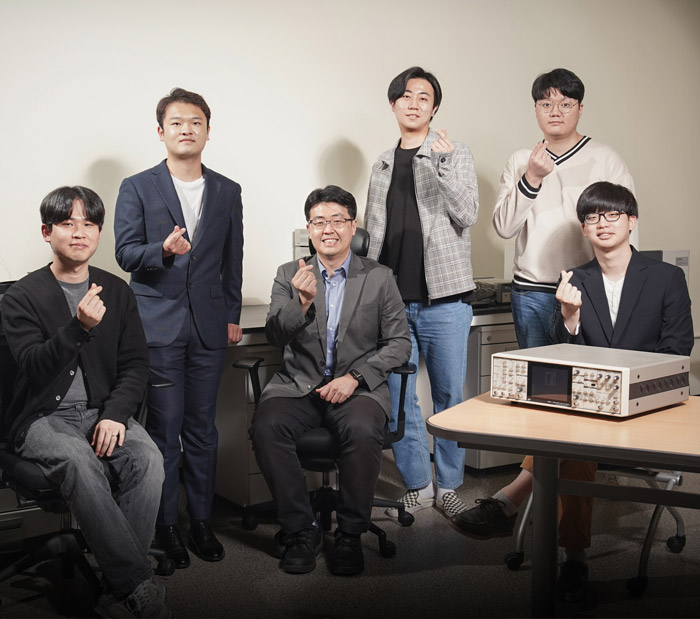
Systems Management Engineering KWON, DAEIL Prof.
Advanced Method to Predict Remaining Useful Life of Li-ion Batteries with State Changes
A research collaboration team led by Prof.Daeil Kwon (Dept. of Systems Management Engineering) and Prof. Jooho Choi(Korea Aerospace University) developed a remaining useful life predictionmethod for secondary batteries with state changes. This research was publishedIEEE Transactions on Industrial Electronics (IF=7.515, Instruments &Instrumentation, JCR top 0.78% in instruments & instrumentation) Most cell phone users may have noticed overthe lifetime that the usage time of their cell phones is becoming short,compared to that of a new phone, even after the phone is fully charged. Thisphenomenon is known as capacity fade, the capacity of li-ion batteriesgradually decreases over repeated charge and discharge cycles. While capacityfading for most batteries is fairly consistent, some batteries show significantcapacity drop after a certain charge and discharge cycles, sometimes resultingin consumer claims. This research developed an advanced methodto accurately predict remaining useful life of secondary batteries even withstate changes. Particle filter, a popular model-based method for battery lifeprediction, may be inappropriate for batteries with state changes. The proposedmethod demonstrated accurate remaining useful life prediction performance bycontinuously learning the changes in battery capacity behavior, and by updatingthe prediction model accordingly. The proposed method is expected to apply tosystems with state changes in analyzing system behavior, as well as predictingremaining useful life, and thus to contribute effective and efficientmanagement of engineering assets.
- No. 161
- 2021-05-27
- 3013
-
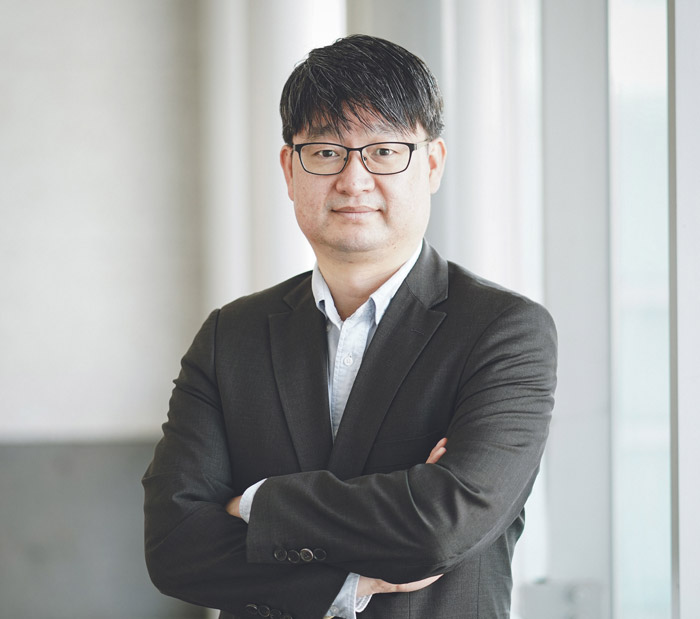
Advanced Materials Science and Engineering BAIK, JEONG MIN Prof.
New Paradigm for Reliable and Sustainable Energy Harvesting Technologies
Contact electrification is a well-known phenomenon in physics, in which opposite charges are created at surfaces due to continuous contact and separation processes occurring between two materials, followed by the generation of electric potentials between them. Triboelectric nanogenerators based on the phenomenon have not only been successfully demonstrated for use as power sources that are sufficient for powering small electronic devices, but they have also been used for sensing momentary stimuli in electronic skin, touch screens, healthcare devices, and habit-recognition security systems. However, the physical contact between two surfaces may have some big drawbacks in TENGs, such as decreases in their output power due to the wear of materials, the need to replace the device, and noise resulting from its operation. Sungkyunkwan University (President Dong Ryeol Shin) has developed a non-contact mode triboelectric nanogenerator with a new dielectric, a C60-containing block polyimide (PI-b-C60). compared with perfluoroalkoxy alkane film-based TENGs, the TENG based on PI-b-C60 generated 4.3 times higher output power and a superior charge density of over 300 μC m−2 with a 3 times slower charge decay rate. With the superior characteristics, a keyless electronic door lock system and a speed sensor with a tone wheel for a car with very sensitive and reliable operations, were developedfor the first time. Team also for the first time suggested a new paradigm to increasing the output voltage of a thermoelectric generator that does not involve material modification by introducing the contact electrification. Thermoelectric energy harvesting is a technology that generates useful energy by utilizing the temperature difference generated at both ends of a material when heat is applied from the outside. But there was still a difficulty in commercialization due to the very low output voltage. As a solution to these challenges, the research team created a polyimide-based polymer layer having negative charges as a triboelectric effect in the cold side of the BiSbTe-based thermoelectric device, which has the highest ZT value at room temperature. As a result, the output power has more than doubled and the world's highest output voltage (50% increase over the previous version) has been achieved. Prof. Baik said “These accomplishments by introducing the contact electrification is the breakthrough technologies for sustainable energy generation in energy harvesting research area.” These studies were published online in Energy & Environmental Science (IF 30.287) and ACS Energy Letters (IF: 19.003).
- No. 160
- 2021-05-17
- 2817
-
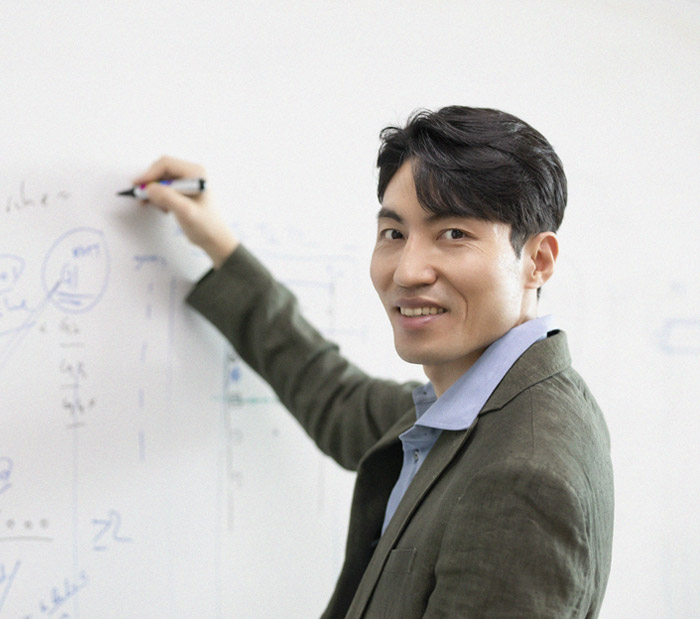
Medicine LEE, JOO SANG Prof. ·Dasol Kim, Youngmin Chung
Synthetic lethality genetic network mediated personalized cancer treatment
Professor Joo Sang Lee’s research team (Next-Gen Medicine Lab, Department of Artificial Intelligence and School of Medicine) demonstrated that they can identify which therapies may be particularly beneficial for individual patients by only looking at the patients’ molecular markup before treatment. When applied to data from a wide panel of different cancer targeted and immunotherapy clinical trials, the approach termed SELECT was successfully predictive of patient responses to these therapies in about 80 percent of the trials. These findings were reported April 13, 2021, in Cell. The study is based on identifying synthetic lethal interactions – a functional interaction between two genes whose co-inactivation leads to cancer cell death. Over 20 years ago, synthetic lethality has been proposed to have a great potential to revolutionize cancer treatment. This is partly because these interactions provide an opportunity to selectively kill only tumor cells while sparing normal cells by targeting synthetic lethal pairs of specific genes inactivated in a tumor. It has been investigated as a means to treat cancer, with some specific treatment regimens already used in the clinic. However, it is thought that many such treatment opportunities remain to be discovered and SELECT offers a computational method for identifying such treatment options for individual patients. By analyzing tumor transcriptomics data, this approach can identify actionable tumor vulnerabilities that are not readily evident by traditional mutational- and gene fusion-based sequencing approaches. In collaboration with Eytan Ruppin (Cancer Data Science Laboratory at National Cancer Institute), Joo Sang Lee together with his students Youngmin Chung and Dasol Kim has been leading the development of computational tools to identify synthetic lethality. In this most recent study, they assembled a broad collection of 35 published transcriptomic datasets from targeted and immunotherapy cancer clinical trials across 10 different cancer types. They applied SELECT to predict the treatment response of the patients, given their tumor molecular data, finding the SELECT signatures to be highly accurate in 80 percent of the trials. “To the best of our knowledge, SELECT is the first approach that systematically achieves these moderate, but helpful levels of accuracy across many different therapies and cancer types,” Lee says. Further investigation is now underway in collaboration with several clinical teams at the NIH Clinical Center to bring SELECT into clinic. The team hopes these prospective studies will further improve SELECT in the next few years, and if successful, establish SELECT as a complementary precision oncology approach for enhancing cancer-patient care.
- No. 159
- 2021-04-30
- 3525
-
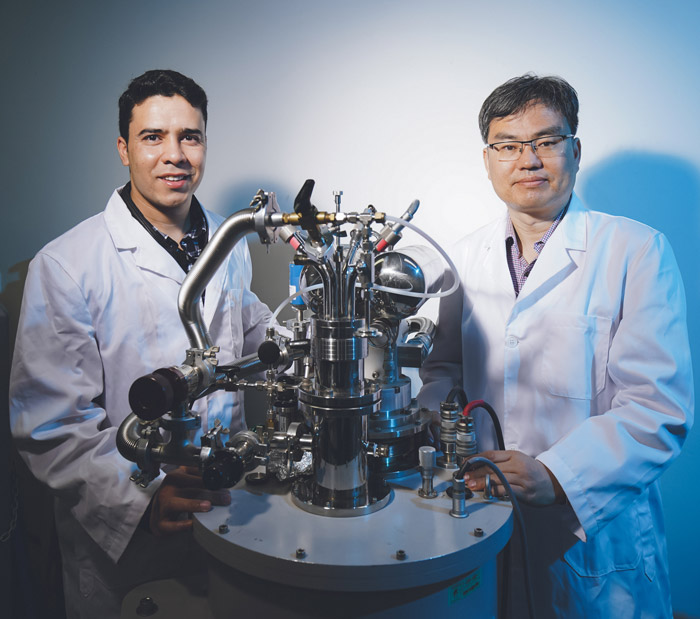
Mechanical Engineering LEE, CHANG GU Prof. ·Dr. Budhi Singh, Dr. Pawan Kumar Srivastava, Dr. Yasir Hassan
Development of Advanced Concept Electronic Devices for THz Technology
In recent years, numerous electronics engineers worldwide have been trying to develop new semiconductor heterostructure devices using atomically thin materials. Among the many devices that can fabricated using these materials are resonant tunnelling diodes, which typically consist of a quantum-well structure placed between two barrier layers. Past research has shown that stacking two-dimensional (2D) layers that are twisted in relation to each other can enhance or suppress the interlayer coupling at their interface. This suppression or enhancement can in turn modulate the electronic, optical and mechanical properties of the resulting device. For instance, some studies found that the intralayer current transport in small angle twisted bilayer graphene prompted some exotic phenomena, such as superconductivity and ferromagnetism. These observations inspired a fundamentally new approach to device engineering, known as ‘twistronics’ (i.e., twist electronics). Researchers at Sungkyunkwan University in South Korea have recently carried out a study aimed at evaluating the potential of a twistronics design for developing resonant tunnelling diodes based on black phosphorus homostructures. The resulting twisted black phosphorus-based resonant tunneling diodes, presented in a paper published in Nature Electronics, exhibit a higher tunnelling conductance than resonant tunnelling diodes based on van der Waals heterostructures. “Interlayer current transport through twisted junctions could also be an intriguing topic of research that has not yet been explored,” Budhi Singh, one of the researchers who carried out the study, said. “This motivated us to investigate interlayer current-transport behavior in twisted black phosphorus-based homostructures.” In a series of laboratory experiments, Singh and his research team identified a number of valuable features that characterize black phosphorus, including its highly anisotropic nature, a thickness-dependent workfunction/2D-carrier density and a twist angle-dependent interlayer coupling. The highly anisotropic nature of black phosphorus ultimately enables a vanishing interlayer coupling strength at specific twist angles. “Interestingly, we found that the interlayer current-transport in such twisted junctions could be controlled even at higher twist angles,” Singh said. “The decoupled interface and momentum mismatch created through twisted Fermi surfaces could also affect the interlayer current-transport behavior and is a part of our primary investigation. In contrast, observation of exotic phenomena in intralayer current transport in twisted junctions is limited to smaller twist angles." To evaluate the potential of the design strategy they devised, the researchers fabricated a black phosphorus tri-layer homojunction, by integrating a thin layer of black phosphorus between two thicker layers. The middle and thinner layer is twisted in relation to the top and bottom black phosphorus layers. “Due to the twisted structure in our devices, the decoupled interfaces behave like a tunnel barrier for interlayer charge carrier transport,” Singh explained. “If we compare this structure with the conventional double barrier resonant tunnelling diode, middle black phosphorus serves as an analogue of the quantum well.” In the device fabricated by Singh and his colleagues, the emergence of a negative differential resistance and the evolution of peak position with a varying thickness of the middle black phosphorus layer produced a signature typically associated with resonant tunnelling diodes. Resonant tunnelling occurs when the energy and momenta of the top and bottom black phosphorus layers match those of the quantum well states, due to processes of energy and momentum conservation. “Whenever we talk about tunnelling phenomena, there has to be a physical barrier (i.e., materials with large energy bandgaps),” Singh said. “In general, this architecture is achieved in a heterostructures assembly, but we demonstrated resonant tunnelling through a homostructure without the need of any physical tunnel barrier.” The twistronics design strategy introduced by Singh and his colleagues could soon inspire the fabrication of other devices that exhibit remarkable tunnelling conductance. In the device created by the researchers, the tunnelling mechanism is dominated by a twist-controlled interlayer coupling, which results in a high tunnelling current density. Their diode device and other twist-controlled tunnel devices with high current densities could ultimately be used to realize a variety of high speed electronics, including THz oscillators and ultrafast switches. “In the near future, we would like to perform experiments to realize twisted black phosphorus homostructures in practical applications, such as THz devices and applications in superconducting spectroscopy.” Image Captions: Figure. (Left) Illustration of the twisted black phosphorus trilayer homojunction device in which a thin black phosphorus is 90o sandwiched between two thick black phosphorus. (Right) Interlayer tunnelling current (ID) through quantum well states revealed the characteristics of a resonant tunnelling diode. References: Resonant tunnelling diodes based on twisted black phosphorus homostructures. <i>Nature Electronics</i>(2021). DOI: 10.1038/s41928-021-00549-1. https://www.nature.com/articles/s41928-021-00549-1
- No. 158
- 2021-04-19
- 3959
-
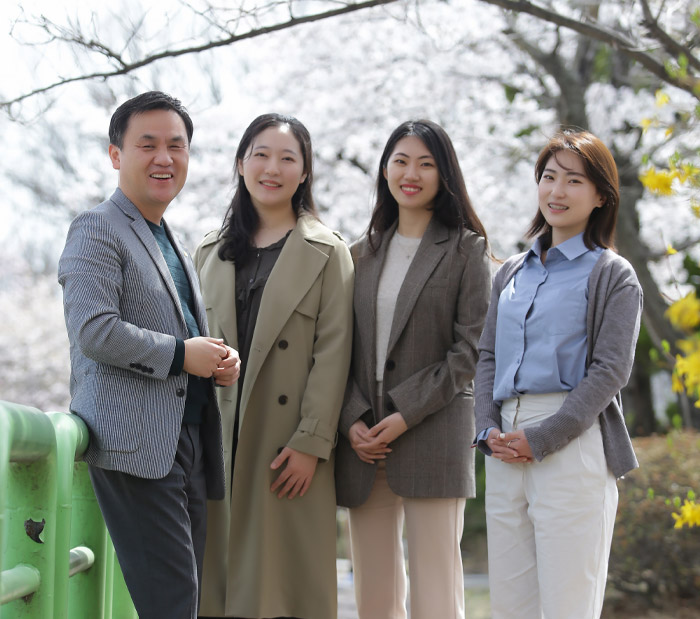
Education BAE, SANG HOON Prof.
A Study on the Changes of Students' Social Emotional Experience and Learning Patterns then and now COVID-19 pandemic
The Education and Future Research Institute (Director Bae Sang-hoon*) published its findings on the changes in students' social emotional experiences and learning patterns around COVID-19. This study was conducted as part of a global joint study conducted with Harvard University's Partnership in Education and Resilience (PEAR) Institute and the Free University of Berlin, which is world-renowned in children's social and emotional development and after-school activities. ※ Prof. Bae (Department of Education) serves as the Editor in chief of world-renowned journal, International Journal for Research on Extended Education in the field of extra-curricular activities. This study is a pilot study of global joint research led by the World Education Research Association International Research Network and participated by 15 countries. The research team (Jin Hye-won in master course, undergraduate researchers Jeon Ji-hye, Jeon Min-kyung, Kim li-yeon, and Jo Su-hyun) analyzed how the student's social emotional experience and learning patterns changed between "the second semester of 2019" and "the first semester of 2020 when School was shut." This study used a questionnaire jointly produced by Sungkyunkwan University and Harvard University researchers, and analyzed the response data of 261 elementary school students, 218 middle school students, and 396 high school students. < Study Contents > Area Factor Source Experience of social emotional development Action Oriented PEAR Perseverance PEAR Relationships with Adults PEAR Optimism PEAR Distress - Learning ability Perception on schools - Self-Directed learning Education and Future Research Institute Collaborative learning Education and Future Research Institute < Harvard Child Development Model> ※ Malti, T., Zuffiano, A., & Noam, G. (2017). Knowing every child: Validation of the holistic student assessment (HSA) as a measure of social-emotional development, Society for Prevention Research. DOI 10.1007/s11121-017-0794-0 The research team pointed out that all social and emotional development factors fell then and now COVID-19. In particular, it was noted that "action oriented” and "Optimism" have decreased significantly. According to Harvard's child development model, students have experienced active participation in social life by doing various physical activities in the early stages of development, and these participation experiences serve as the foundation for the next stage of social emotional development. For this reason, many developed countries emphasize after-school activities in early childhood. The research team pointed out that “action-oriented” decreased the most in the elementary school group, which was interpreted as a result of the decrease in individual external activities amid limited movements for school, school sports, and after-school activities. Researchers at the Institute for Education and Future predicted that social distancing under COVID-19 will continue for a while, stressing the need for students to follow quarantine rules while properly doing physical activities such as walking in park with family and friends. He also pointed out that fewer activities and social interactions with peers could seriously affect students' social emotional development, and that parents' special attention and careful guidance are needed to comply with quarantine rules such as wearing masks in well-ventilated spaces. “Optimism”is a necessary developmental experience, especially at a mature stage on development. According to the research team, this perception has decreased significantly since COVID-19. The research team said that the social situation, in which expectations for the end of COVID-19 are reduced due to repeated large-scale spread of COVID-19, is believed to have had a negative impact on forming a positive attitude toward life. In addition, the researchers found that the decrease in activities (meeting friends, exercises to relieve stress, etc.) that could gain positive emotions in social communities as students spent more time indoors had a negative impact on forming positive perceptions of life. The researchers emphasized that positive perception of life is a key factor in enhancing learning participation and academic performance by promoting academic motivation and social exchange. Therefore, special interest and measures are needed for students who are experiencing alienation and depression in isolation. Professor Bae Sang-hoon, who led the research team, said, "It should be highly appreciated that Korea has maintained the safety and health of the people through K-Discipline. However, it is time to pay attention to the developmental delays and educational deficits of students in the face of the situation where the school's restrictions on schooling and the expansion of non-face-to-face online classes become new normal. "“In particular, if students miss out on the social and emotional experiences they should have at each developmental stage, this may be a difficult developmental loss to recover easily, so special attention is needed in schools and families,” he said. “If we were concerned about technical support for stable online classes as we had to do online classes in 2020, we should now make more efforts to improve the quality of education.” he said. In particular, the education authorities and schools should make a lot of efforts to create class design and evaluation plans to promote vulnerable self-directed learning and cooperative learning in online classes. The development and learning of students is based on continuous and systematic interaction. If social distance and remote learning are expanded, such intellectual interaction, emotional exchange, and social activities may be reduced. In future society, empathy and consideration are essential competencies to live as mature members of society. Therefore, class design is required to supplement them and parents' attention is required during the time of staying at home. Finally, Professor Bae noted that the delays and learning deficits of socio-emotional development that appeared before and after Corona 19 were more significant in socio-economic vulnerable groups, and it is an important social and educational task to build an educational safety net for these classes and to take careful care.
- No. 157
- 2021-04-07
- 2883
-
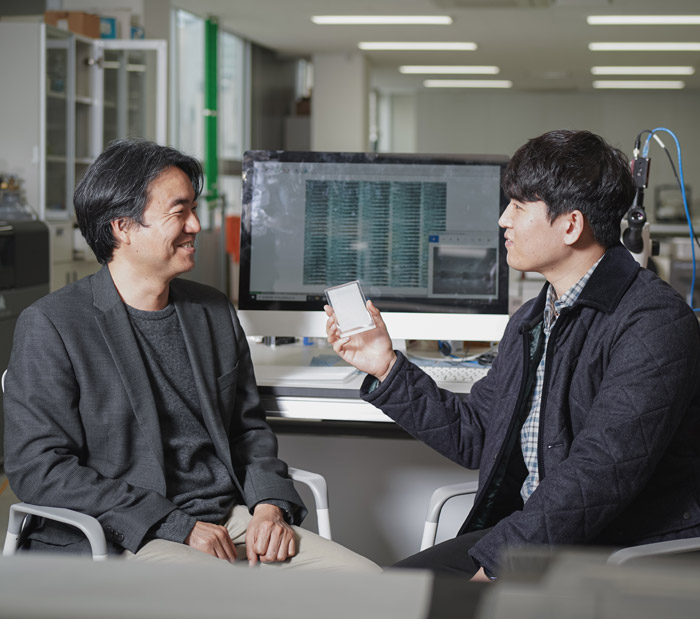
Mechanical Engineering LEE, JIN KEE Prof. ·Dr. MinKi Lee
Development of a 3D Liquid Transporting Diode Surface Using Nature-inspired Technology
Sungkyunkwan University (President Dong Ryeol Shin) announces that Prof. Jinkee Lee in School of Mechanical Engineering & Institute of Quantum Biophysics has developed a 3D liquid transporting diode surface using nature-inspired technology (first author Dr. MinKi Lee). This liquid transporting system has advantages for easy fabrication, cost-effectiveness, high scalability and shows the world's highest performance with novel 3D structure. When a liquid droplet is dispensed on the surface, the liquid transports uni-directionally by the passive capillary control from the structures of the liquid diode. Up to now, diode surfaces have been manufactured using lithography processes or 3D printer, which have drawbacks of limited size with complicated manufacturing processes, and also they show low liquid transport performance. Many researchers have been investigating the diode surface but it is quite challenging to increase both the transport performance and the ease of surface manufacturing, simultaneously. Prof. Jinkee Lee developed nature-inspired diode surface, which mimics the surface from nature such as horned lizard and pitcher plant. The 3D diode surface has a wedge structure consisting of repeating saw-like V-grooves. This surface utilizes the capillary force generated by the 3D topographical shape that pins liquid at one size and makes it flow to the other side. The fabrication of 3D diode surface is easy, fast, cost-effective and scalable because it is processed simply using a laser cutter. Professor Jinkee Lee said, “This 3D water transport diode surface can be applied as an original technology applying to microfluidic diagnostic chips, material synthesis, heat transfer enhancement and even fog collection because of its superior performance and easy fabrication.” This study was supported by the National Research Foundation of Korea (NRF; 2020R1A2C3010568) and the Korea Environment Industry & Technology Institute (KEITI; 2019002790003), and was published online on March 20, 2021 in Advanced Functional Materials (IF=16.836). ※ Title of paper : “Enhanced Liquid Transport on a Highly Scalable, Cost‐Effective, and Flexible 3D Topological Liquid Capillary Diode”
- No. 156
- 2021-03-29
- 2643
-
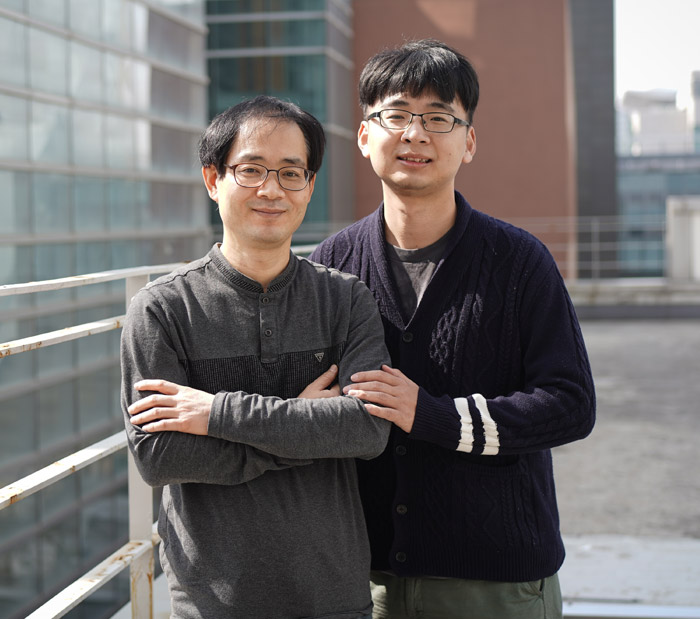
Chemistry LEE, JINYONG Prof.
Development of New Treatment for PDT for Hypoxic Cancer, Suggestion of New Theranostic Method for PDT
[Development of a New Treatment for Photodynamic Theraphy (PDT) for Hypoxic Cancer] A research collaboration team led by Prof. Jin Yong Lee (co-first author: Hao Li, Dept. of Chemistry) and Prof. Jong Seung Kim at Korea University (co-first authors: Dr. Miae Won and Dr. Seyoung Koo) announced that they have developed a new treatment for photodynamic therapy for hypoxic cancer through joint research. Since photodynamic therapy requires reactive oxygen, it has limitations in its application to hypoxic cancer. The research team proposed a new method for photodynamic therapy for hypoxic cancer by simultaneously causing reactive oxygen generation and inhibition of GST-pi. The joint research team of Sungkyunkwan University and Korea University combines BPS, an existing photosensitizer, with EA to generate reactive oxygen and inhibits GST-pi, an enzyme that interferes with photodynamic therapy by free radicals, to improve the efficiency of photodynamic therapy for hypoxic cancer. Currently, photodynamic therapy is clinically approved, but reactive oxygen must be present for the treatment. Therefore, there is a limit to application to hypoxic cancer that lacks oxygen around cancer cells. In order to overcome this, various attempts have been made to transport oxygen and to generate oxygen, but there were difficulties due to side reactions from excessive production of active oxygen. To solve these difficulties, the joint research team improved the performance of photodynamic chemotherapy for hypoxic cancer by covalently binding EA to BPS, an existing photosensitizer. EA-BPS serves to scavenge glutathione (GSH) by delivering EA and reduce the activity of the GST-pi enzyme. In particular, through experiments, it was confirmed that EA-BPS lowered the activity of GST-pi by promoting lysosome decomposition and lipid peroxidation. In addition, docking and molecular dynamics (MD) simulations were performed to reveal that five residues (chain A: F7, W37 and Y107; chain B: Y107 and A120) play an important role in the active site, and it was revealed that EA-BPS was interacting with GST-pi enzyme pocket through two subunits instead of one subunit. Professors Lee and Kim said, "The EA-BPS developed in this study has proven its excellent therapeutic effect in a xenograft tumor mouse model, and based on this, we are looking for ways that can be applied to the clinic. It is expected to present a new path for the development of photodynamic therapy for hypoxic cancer." The results of this study was published in the journal "Angewandte Chemie International Edition (ACIE; IF=12.959)" (Feb 8, 2021). [ Suggestion of a New Method that Could be Used in an Easy and Convertable Theranostic for Photodynamic Theraphy] A research collaboration team led by Prof. Jin Yong Lee (co-first author: Hao Li, Dept. of Chemistry) and Prof. Juyoung Yoon at Ewha Womans University (co-first authors: Dr. Hong-Bo Cheng and Dr. Bin Qiao) announced that they have developed a new reversible photodynamic chemotherapy method through joint research. It is very difficult and challenging to develop photosensitizers that can reversibly control free radicals for photodynamic therapy. The research team used porphyrin and DIA as building blocks to create HSA-DIA-porphyrin nanoparticles through self-assembly with HSA, which suggested a new method that could be used in an easy and convertible theranostic for photodynamic immunotherapy. The development of activatable photosensitizers to allow for the reversible control of singlet oxygen (1O2) production for photodynamic therapy (PDT) faces great challenges. Fortunately, the flourishing field of supramolecular biotechnology provides more effective strategies for activatable PDT systems. The joint research tream developed a new reversible PDT on a switch that controls the 1O2 generation of self-assembled albumin nanotheranostics in vitro and in vivo. A new molecular design principle of aggregation-induced self-quenching photochromism and albumin on-photoswitching was demonstrated using a new asymmetric, synthetic diarylethene moiety DIA. The photosensitizer porphyrin and DIA were incorporated as building blocks in a glutaraldehyde-induced covalent albumin cross-linking nanoplatform, HSA−DIA−porphyrin nanoparticles (NPs). More importantly, the excellent photoswitching property of DIA enables the resultant nanoplatform to act as a facile, switchable strategy for photodynamic-immunotherapy. In addition, through docking and molecular dynamics (MD) simulations, three binding modes (heme binding site, cracked binding site, and other binding sites bound to the FA7 region) were identified, and HSA (Human Serum Albumin) preferred antiparallel fashion in binding to DIA rather than parallel. Prof. Lee and Prof. Yoon said, "The synthesis of a non-invasive trigger that reversibly regulates the production of free radicals is a very important in the development of photodynamic chemotherapy drugs, and this study presents a new avenue." The results of this study was published in "Journal of the American Chemical Society (JACS; IF=14.612)". (Feb 10, 2021)
- No. 155
- 2021-03-23
- 2562
-
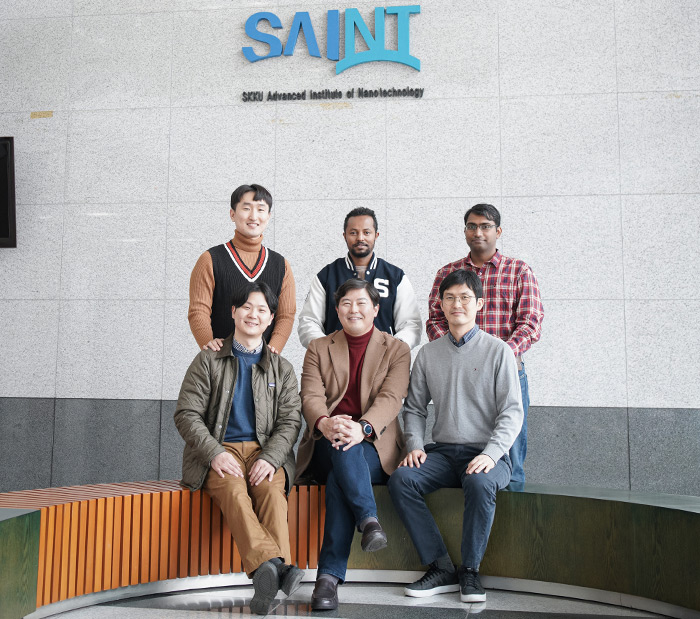
Mechanical Engineering KIM, TAESUNG Prof. ·Prof. Ji Won Suk, Ph.D. Hyeong-U Kim
Development of a New Technology for 2D Transition Metal Chalcogenides
Prof. Kim, Taesung (School of mechanical engineering/SAINT) developed a new technology for two-dimensional (2D) transition metal chalcogenides (TMDs) for the first time in 2015 using plasma-enhanced chemical vapor deposition (PE-CVD) instead of SiOx and SiNx. It is great significance in overcoming the limitations of conventional synthetic techniques (thermal chemical vapor deposition, mechanical exfoliation) such as high process temperature (>550 oC) and small dimensions (size a few cm). ICP type with shower type of nozzle can achieve high uniformity with 4-inch large size using PECVD. In addition, the high-density plasma of ICP has unique properties by inducing the nano size of grain. From 2015 to the present, various 2D TMDs have been successfully synthesized using PE-CVD and many papers(※) and patents have been published. Also, this time, we succeeded in fabricating TMDs-TMDs heterostructure for 4-inch wafer scale. Prof. Taesung Kim’s group (Hyunho Seok, Chaitanya Kanade) and Dr. Hyeong-U Kim (KIMM) developed a new technology using the heterostructure of TMDs-TMDs with experience in synthesis know-how using PECVD. Moreover, Prof. Ji Won Seok’s group (Yonas T. Megra) analyzed the interfacial adhesion properties between the synthesized MoS2-WS2 heterostructures and substrates. It validates the structural stability of the interfaces between MoS2 and WS2. Regarding this research, Prof. Kim said, “We can use cold plasma to overcome the limitations of conventional heterostructure fabrication such as, low uniformity and small size and can be applied to TMDs heterostructure research with high potential for mass production in the near future.” A related research paper, ‘Low-Temperature Synthesis of Wafer-Scale MoS2-WS2 Vertical Heterostructures by Single-Step Penetrative Plasma Sulfurization’ was published in ‘ACS Nano’ (I.F.=14.588, JCR <10%). This research was supported by the National Research Foundation of Korea (NRF) 2018R1D1A1B07040292, 2017R1A2B3011222, and 2019R1A2C2089785. ※ PECVD 2D Materials Synthesis Related Papers (Prof. Kim, Taesung’s Group) 1) Low-Temperature Synthesis of Large-Scale Molybdenum Disulfide Thin Films Directly on a Plastic Substrate Using Plasma-Enhanced Chemical Vapor Deposition (H.-U. Kim et al., Advanced Materials, 27, 2015, 5223-5229) 2) Highly uniform wafer-scale synthesis of α-MoO3 by plasma enhanced chemical vapor deposition (H.-U. Kim et al., Nanotechnology, 28, 2017, 175601) 3) Low-temperature wafer-scale growth of MoS2-graphene heterostructures (H.-U. Kim et al., Applied Surface Science, 470, 2019, 129-134) 4) Wafer-Scale and Low-Temperature Growth of 1T-WS2 Film for Efficient and Stable Hydrogen Evolution Reaction (H.-U. Kim et al., Small, 16, 2020, 1905000) 5) Flexible MoS2–Polyimide Electrode for Electrochemical Biosensors and Their Applications for the Highly Sensitive Quantification of Endocrine Hormones: PTH, T3, and T4 (H.-U. Kim et al., Analytical Chemistry, 92, 2020, 6327-6333) 6) Realization of Wafer‐Scale 1T‐MoS2 Film for Efficient Hydrogen Evolution Reaction (H.-U. Kim et al., ChemSusChem, 2021) doi.org/10.1002/cssc.202002578 7) Low-Temperature and Large-Scale Production of Transition Metal Sulfide Vertical Heterostructure and Its Application for Photodetectors (Chaitanya et al., ACS Applied Materials & Interface, 2021) 8) Low-Temperature Synthesis of Wafer-Scale MoS2-WS2 Vertical Heterostructures by Single-Step Penetrative Plasma Sulfurization (H. Seok et al., ACS Nano, 15, 2021, 707-718)
- No. 154
- 2021-03-08
- 2472
-
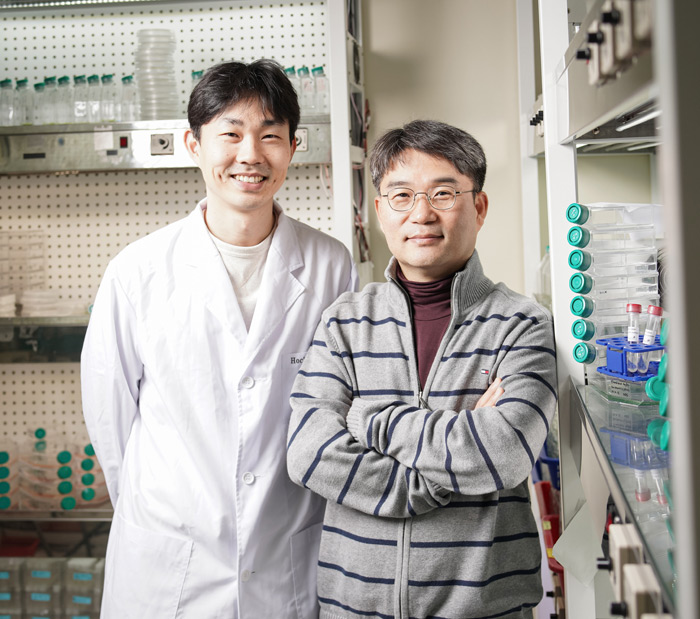
Biological Sciences YOON, HWAN SU Prof.
Chloroplast Evolution Revealed by Research on Photosynthetic Amoeba
A research team led by Prof. Hwan Su Yoon (Department of Biological Sciences at Sungkyunkwan University), together with the research team of Prof. Bhattacharya published a paper on the evolutionary process of chloroplasts in the photosynthetic amoebae, Paulinella micropora. Chloroplasts are the powerhouses of many aquatic and terrestrial ecosystems. The chloroplast in algae and plants originated more than 1 billion years ago and therefore offers limited insights into the initial stages of chloroplast evolution. To address this issue, we focused on the photosynthetic amoeba Paulinella micropora that acquired chloroplast recently (∼124 million years ago) from the independent cyanobacterial origin. Paulinella genome revealed how foreign genes from cyanobacteria and other bacteria affected during the evolution of the chloroplast. In plant cells, proteins involved in photosynthesis are targeted to the chloroplast. Short amino acid sequences called signal peptides are involved in this process. The research team discovered a unique chloroplast signal peptide in Paulinella, which has a plant-independent origin. Moreover, most of the chloroplast targeted proteins were originated from amoeba host, suggesting dominant host contribution to chloroplast evolution. As a model organism showing what happened in the early evolution process of plants, the research on photosynthetic Paulinella is important. Paulinella genome information can be used as basic data for research on applied fields such as synthetic biology and genetic engineering that maximize photosynthesis efficiency. [Image] photosynthetic Paulinella Published article: Duckhyun Lhee, JunMo Lee, Khaoula Ettahi, Chung Hyun Cho, Ji-San Ha, Ya-Fan Chan, Udi Zelzion, Timothy G Stephens, Dana C Price, Arwa Gabr, Eva C M Nowack, Debashish Bhattacharya, Hwan Su Yoon, Amoeba Genome Reveals Dominant Host Contribution to Plastid Endosymbiosis, Molecular Biology and Evolution, Volume 38, Issue 2, February 2021, Pages 344–357, https://doi.org/10.1093/molbev/msaa206
- No. 153
- 2021-02-26
- 2713
-
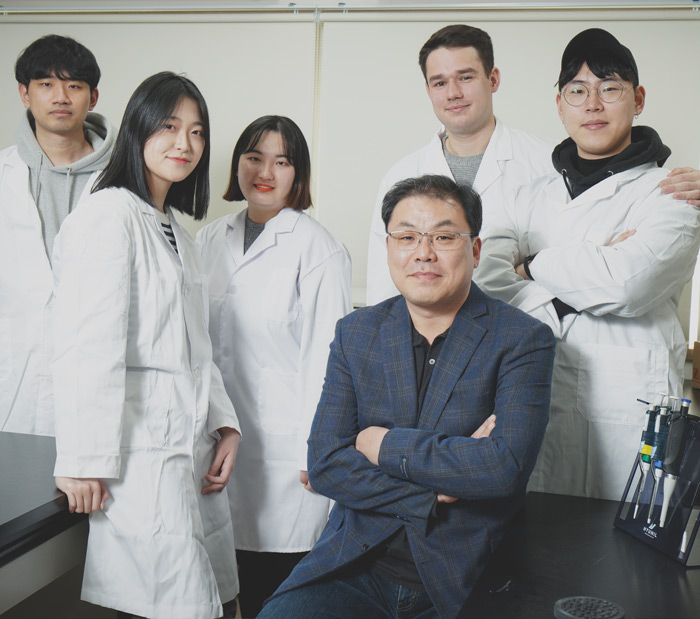
Integrative Biotechnology JEON, YOUNG-JUN Prof.
Suggests Possibility of Applicable Personalized Cancer Therapy Using Radiation Therapy
- The current study shows that the mutations in KEAP1/NFE2L2 genes have a power to predict for local recurrence of the patients after radiation therapy. - The resistance evoked by these mutations may allow personalized radiosensitization of KEAP1/NFE2L2-driven NSCLC, suggesting that the concept of the cancer personalization could be extended to radiation therapeutics. Figure 1. Schematic diagram showing the study design about which the KEAP1/NFE2L2 mutations are predictive biomarkers of local recurrence after radiation treatment in NSCLC Image Excepted : Cancer Discovery DOI:10.1158/2159-8290.CD-20-0282 Young-Jun Jeon’s research teams in the department of Integrative Biotechnology, Sungkyunkwan university published that the mutations in KEAP1/NFE2L2 gene could predict local recurrence of the NSCLC patients after radiation therapy. This study was done by collaboration with Stanford University and supported by NRF grant (NRF-2020R1F1A1071579). Personalized cancer therapy has not been routinely applied to the cancer patients using radiation therapy. To this end, the teams analyzed 232 consecutive patients with localized NSCLC using next generation sequencing (NGS) analysis and found that an important anti-oxidant responsible factor, KEAP1/NFE2L2 genes harboring oncogenic mutations were highly correlated with the local recurrence of NSCLC patients after radiation therapy but not surgery. Subsequently they generated CRISPR-knocked out lung cancer cell lines for KEAP1 genes to test whether a patient derived-KEAP1 or NFE2L2 mutation has oncogenic property and found the pathogenic mutations of the critical anti-oxidant responsible genes are associated with radiation resistance. Also, subsequent cell biological approaches revealed that the inhibition of glutamine metabolic pathway known as an addicted pathway in lung cancer may allow personalized re-sensitizing KEAP1/NFE2L2-driven NSCLC. Figure 2. Strategy for assessing KEAP1/NFE2L2 mutation functional classification using isogenic lung cancer cell lines This study not only claimed the cancer personalization applicable to treatment strategy with radiation therapy in other localized cancers but also suggest a new paradigm in the personalized cancer therapeutics. These results featured on the cover in Cancer Discovery (Vol 10, Issue 12), a top ranked journal in the fields of Oncology (Impact factor – 29.497). Young-Jun Jeon’s research team is currently developing a NGS library platform to analyze circulating tumor nucleic acids from patient blood plasma as a liquid biopsy tool, which will be eventually applied to identify novel mechanistic and prognostic biomarkers by combining cancer biological approaches.
- No. 152
- 2021-02-16
- 2697
-
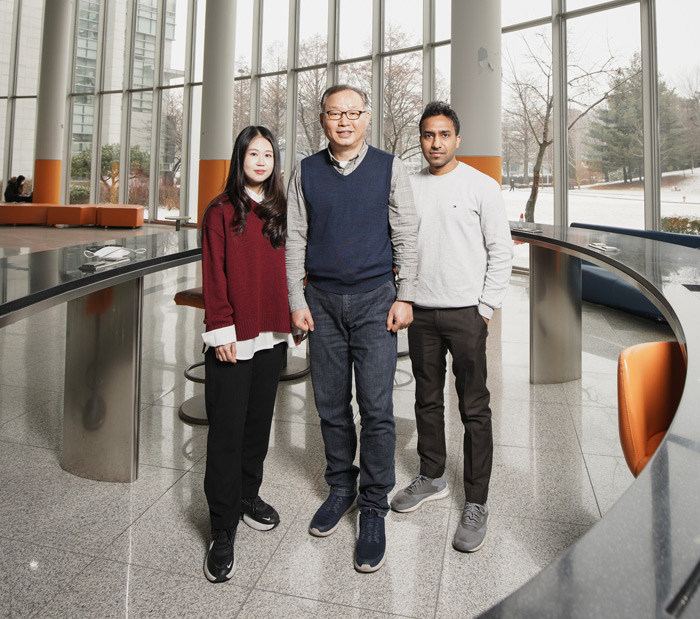
Chemistry LEE, HYOYOUNG Prof.
Development of highly efficient and long-lasting electrocatalyst for water oxidation
Abundant. Clean. Flexible. Alluring enough to explain why hydrogen, the most common molecule in the universe happens to have its name as part of an national Hydrogen and Fuel Cell Day. Chosen to signify hydrogen's atomic weight of 1.008, the U.S. Department of Energy's Office of Energy Efficiency and Renewable Energy celebrates advances in hydrogen-use technology every October 8 since 2015. When hydrogen is consumed in a fuel cell (which takes the water molecule H2O and seperates it into oxygen and hydrogen, a process called electrolysis), it only produces water, electricity, and heat. As a zero-carbon energy source, the range of its potential use is limitless: transportation, commercial, industrial, residential, and portable. While traditional hydrogen production processes required fossil fuels or CO2, electrolysis produces “green hydrogen” from water molecules. Since water cannot be split into hydrogen and oxygen by itself, the electrochemical hydrogen-water conversion needs highly active electrocatalysts. The conventional water electrolysis, however, faces technological challenges to improve the efficiency of the water-splitting reaction for the sluggish oxygen evolution reaction. Noble metal-based ruthenium oxide (RuO2) and iridium oxide (IrO2) are used to enhance the oxygen generation rate. However, these noble metal catalysts are very expensive and show poor stability under long-term operation. Led by Associate Director LEE Hyoyoung of the Center for Integrated Nanostructure Physics within the Institute for Basic Science (IBS) located at Sungkyunkwan University, the IBS research team developed a highly efficient and long-lasting electrocatalyst for water oxidation using cobalt, iron, and a minimal amount of ruthenium. “We used ‘amphiphilic block copolymers’ to control electrostatic attraction in our single ruthenium (Ru) atom-bimetallic alloy. The copolymers facilitate the synthesis of spherical clusters of hydrocarbon molecules whose soluble and insoluble segments form the core and shell. In this study, their tendency for a unique chemical structure allows the synthesis of the “high-performance” single atomic Ru alloy present atop the stable cobalt iron (Co-Fe) metallic composite surrounded by porous, defective and graphitic carbon shell,” says LEE Jinsun and Kumar Ashwani, the co-first authors of the study. “We were very excited to discover that pre-adsorbed surface oxygen on the Co-Fe alloy surface, absorbed during the synthesis process, stabilizes one of the important intermediates (OOH*) during the oxygen generation reaction, boosting the overall efficiency of the catalytic reaction. The pre-absorbed surface oxygen has been of little interest until our finding,” notes Associate Director Lee, the corresponding author of the study. The researchers found that four hour-annealing at 750°C in an argon atmosphere is the best appropriate condition for the oxygen generating process. In addition to the reaction-friendly environment on the host metal surface, the single Ru atom, where oxygen generation takes place, also fulfills its role by lowering the energy barrier, synergistically enhancing the efficiency of oxygen evolution. The research team evaluated the catalytic efficiency with the overvoltage metrics needed for the oxygen evolution reaction. The advanced noble electrocatalyst required only 180 mV (millivolt) overvoltage to attain a current density of 10 mA (milliampere) per cm2 of catalyst, while ruthenium oxide needed 298 mV. In addition, the single Ru atom-bimetallic alloy showed long-term stability for 100 hours without any change of structure. Furthermore, the cobalt and iron alloy with graphitic carbon also compensated electrical conductivity and enhanced the oxygen evolution rate. Associate Director Lee explains, “This study takes us a step closer to a carbon-free, and green hydrogen economy. This highly efficient and inexpensive oxygen generation electro-catalyst will help us overcome long-term challenges of the fossil fuel refining process: to produce high-purity hydrogen for commercial applications at a low price and in an eco-friendly manner.” The study was published online on November 4 in the journal Energy & Environmental Science. [Image 1] Crystal structure of surface oxygen-rich metal alloy (top left). Oxygen and hydrogen are generated during a water electrolysis reaction (top right). The designed catalyst exhibits the best oxygen evolution activity with minimal overpotential (bottom panels). - References Jinsun Lee, Ashwani Kumar, Taehun Yang, Xinghui Liu, Amol R. Jadhav, G. Hwan Park, Yosep Hwang, Jianmin Yu, Chau T. K. Nguyen, Yang Liu, Sara Ajmal, Min Gyu Kim and Hyoyoung Lee. Stabilizing OOH* intermediate via pre-adsorbed surface oxygen of single Ru atom-bimetallic alloy for ultralow overpotential oxygen generation. Energy & Environmental Science. 2020. DOI: 10.1039/D0EE03183F
- No. 151
- 2021-02-03
- 3013


